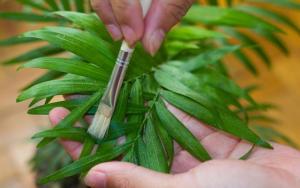A layer of dust on leaves can block light and stress your plants
You are dust and you shall return to dust...which is why I don't dust my house: it could be someone I knew. Dust makes for spectacular sunsets among other things, but dust can be a killer for your houseplants.
Because plants produce chemical energy from sunlight, a layer of dust on the leaves can block the light and stress your plants. When this happens, houseplants give off less oxygen, and you lose some of the health benefit of having houseplants. Lack of sunlight will eventually kill the plants.
How often you dust your plants depends upon how dusty your home is. Open windows and dry temperatures tend to create more indoor dust.
For plants with smooth leaves just use lukewarm water and a soft cloth, and gently wipe the leaves. A soft sponge or a soft microfiber cloth like the type used to polish cars can be ideal. Rinse the sponge or microfiber cloth periodically so you don't spread wet dust on the leaves. If the leaves are especially dirty or have caked-on dirt, you might want to add a drop or two of mild dish detergent into the water. Finish with plain water and make sure you wipe off any soap residue.
You can put hardy plants in the sink and rinse them under a light spray of lukewarm water. Adjust the water pressure so that it is low enough not to damage the leaves or break stems. Large plants can be gently hosed off in the shower. Let the houseplant dry in the sink before moving it back to its regular place.
A feather duster or even a small paintbrush is great for dusting succulents, cacti or plants with hairy leaves such as African violets (Saintpaulia). Lightly brush the dust from the stem outward on the leaf.
Never use leaf shine products to polish the leaves of houseplants, because they will often clog the leaves’ pores, and actually stop photosynthesis.
When dusting plants, support each leaf with one hand so you don't accidentally break or damage the leaves or stems.
While you are dusting your plants, it is a good time to inspect them for pests as well as dead or broken leaves and stems. Insects often hide under leaves, so gently bend leaves over and look for bugs. Pay special attention to where leaves attach to stems, as this is a common place for bugs.
If you find any webbing, it could be a sign of spider mites. Diseases will often show up as spots on leaves, so be on the lookout for any spots or discolored parts of leaves.
Dead leaves are not only unsightly; they can harbor pests. Cutting off dead leaves not only improves the plant's appearance; it lets more nutrients reach the remaining leaves. Cutting out dead stems and leaves also allows better air circulation and prevents mold.
Clean up around your houseplants and dust them regularly. You will enjoy healthier plants that give off more oxygen. After all, you don't want them to die, or as cowboys say, to bite the dust.





















































